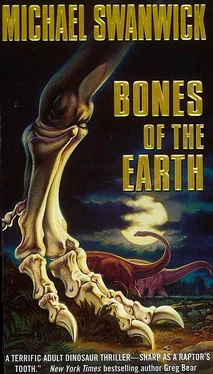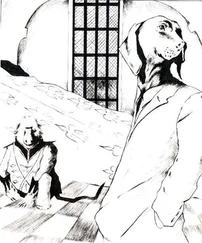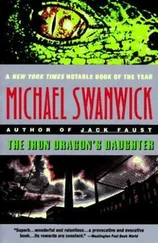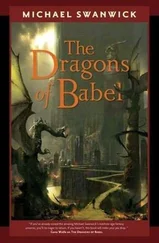“Secondary featherlessness?” He laughed. “Is this anything like your secondarily flightless Apatosaurus?”
“Cut me some slack—I was fifteen when I wrote that paper suggesting that dinosaurs were descended from volant reptiles.”
“But they’ve gone back to the Triassic, and nobody’s found a living specimen of your hypothetical ancestor. How do you explain that?”
“Tell me something, Monk. How many important scientists—important ones—do you think made it to the senior prom?”
“I honestly can’t say I’ve given it much thought.”
“Hardly any. Here’s something I’ve observed—the most popular kids in high school never become much of anything. They peak in their senior year. It’s the dweebs, geeks, and misfits, the fringe types, the loners, who grow up to be Elvis Presley or Richard Feynman or Georgia O’Keeffe. And, similarly, it isn’t the successful organisms that evolve into totally new forms. The successful organisms stay where they are, growing more and more perfectly adapted to their ecological niche until something shakes that niche and they all die. It’s the fringe types that suddenly come up out of nowhere to fill the world with herds of triceratopses.”
“Well, that’s one way of looking…”
“The first feathered animal, whatever it was, was small and obscure. It developed something that gave it a very slight edge in a very marginal niche, and then it stayed in the shadows for a long time. Until God rolled the dice again, and scrambled all the niches. Dinosaurs were like that, back in the Triassic—just one nerdy group of archosaurs out of many, and far from the most successful one. My feathered pseudosuchian, too.
“Those guys back in the Triassic are looking in all the obvious places. Wrong. If I ever get the goddamned bureaucracy to post me back that far, you can bet I’ll be poking around behind the bleachers and out on the fire escape.”
Monk shook his head admiringly. “You never give up, do you?”
“I beg your pardon.”
“Admit it. The evidence so far is all against you. Odds are, you’re completely wrong.”
“Wait and see, Monk. Wait and see.”
From ahead, where the dunes gave way to salt marshes, came the low warbling sound that a camptosaur herd makes when something spooks it.
Monk shivered and glanced nervously inland, where the brush gave way to scrub pines. “It’s not dangerous out here, I hope?”
Camptosaurs were skittish beasts, as likely to be frightened by their own imaginations as by a carnivore. But Salley felt no obligation to spell things out to Monk. “You’re not much of a field man, are you?” she said amiably.
They walked on in silence for a time. The trail across the dunes was faint, but definite. In all the world, only humans made trails like that, running parallel to the seashore. Salley thought of all the human trails the researchers had made, radiating out in a dwindling fan from Bohemia Station. It got her to thinking about dino trails. There were thousands of them in the brush. If they could be mapped and classified by user species, what a wealth of behavioral information it would reveal! Too much and too tedious work for her to do by herself, of course. But if she could get a couple of grad students assigned to her…
“At age twenty-three, you were almost famous.”
“Huh? Oh. Yes.”
“Why don’t you tell me the whole story?”
“Well, I had the fossil, and nobody would even look at it. So I decided to do an end-run around the process. I spent a day calling up every major news outlet in the hemisphere and saying, ‘This is Dr. G. C. Salley, of Yale University. I’m calling to announce an extraordinary discovery.’ Then I’d very carefully explain to them that since the last quarter of the twentieth century it has been generally accepted by the scientific community that birds were directly descended from dinosaurs and that therefore dinosaurs were no longer extinct. You have to spell things out for the press—you can’t rely on them to know even the simplest things.”
“And then?”
“Then I explained about my fossil. I told them that this meant that birds were not descended from dinosaurs, but from animals that existed before dinosaurs evolved. That birds were at best a sister clade to dinosaurs. And I capped it by declaring, ‘Dinosaurs are extinct again!’ They ate it up and licked the spoon afterwards.”
The musky smells of the dunes, with their hints of cinnamon and bayberry, took on a darker tinge of sulfur and rotting vegetation. They’d come to the edge of the salt marsh. The trail divided here into two barely-visible tracks, one leading into the marsh and one into the woods. “We head inland here.”
Cycads and low conifers rose up to either side of the trail. They passed into green shadow, walking single file and listening for predators.
Salley wondered how much it would cost to put a Global Positioning System in place. Then anytime a researcher used an animal trail, it could be automatically tracked and recorded, and dumped in a database for analysis back in the twenty-first century. The only trouble would be how to identify which individual trails were made by which animals. But that was grad student work again, and it was easier to get grad students when you didn’t have to arrange funding to take them out into the field.
“How would you handle it today?” Monk asked abruptly.
“Handle what?”
“Your feathered fossil. If you had it to do all over again.”
She pretended to think, briefly, though she’d gone over the scenario in her mind so many times it almost felt as though it had already happened. “Well, today I’ve still got a touch of residual fame, so I’d call a press conference instead of working the phones. I’d get myself all glammed up to help ensure they gave the story some coverage. And this time I’d make sure I had a real good specimen. The one I had was too fragmented. They said it was a mosaic of different species jumbled together. They said the feather trace was just dendrites. I should’ve gone back out and dug until I found something complete. Something flashy. Something that nobody could deny.”
“That’s the key, then?”
“A killer specimen. You got it.”
The trail twisted, and there ahead of them was the blind. The walls were made of small tree trunks lashed together, and the roof was thatched with cycad leaves. It sat at the edge of the woods, overlooking a browse plain that had recently been eaten clear by sauropods and now held only low vegetation. “Last man-made structure for 7,900 miles,” Salley said. “Lydia built it herself with a hatchet and a ball of twine.”
* * *
Lydia Pell was sitting in her blind, knitting and reading a book propped up on the shelf beneath the window slit. She put down her knitting and turned off the book when they came in. Salley introduced her to Monk, and then said, “Tell him what you’re up to here.”
Lydia was round-faced and plump, in a middle-aged way. She opened up two camp chairs for her guests, and said, “Well, it’s quite a story. I was making my rounds and, among other things, I had in mind to check up on a widow fisher whose nest I had found, when—”
“Widow fisher?” Monk asked.
“Eogripeus hoffmannii. It means ‘dawn-fisher.’ Named after Phil Hoffmann because it was one of his students who identified it as a basal spinosaur, maybe even the node taxon for the clade.” She put a finger to her chin and smiled so he would understand that the student was herself. “A great big thing with a narrow little snout like a crocodile’s. Out in the field, we just call them fishers. This particular fisher was a widow because her mate had been eaten by allosaurs a couple of days before.”
Читать дальше






